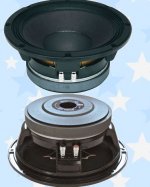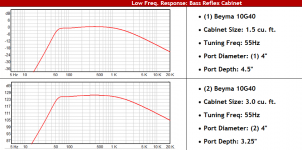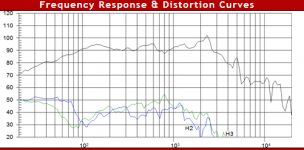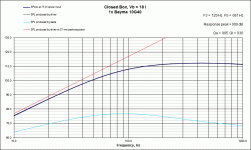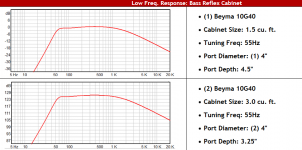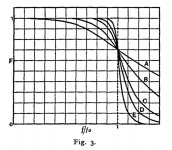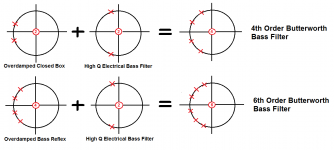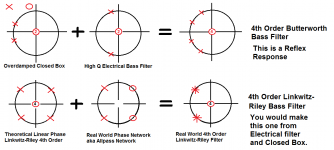Neither work.
The Butterworth rolls off @ 122Hz but you want/need roll off at 70Hz.
The LR (Q=0.5 for a cascaded Butterworth) rolls off at 78Hz but will be down by many dB at this frequency.
You need EQ which will overload your speaker, or you need a bigger speaker.
Try to find a driver and box that with Butterworth loading rolls off at your preferred frequency.
Alternatively use this smaller driver in it's smaler box with the 122Hz Butterworth and add on a bass only speaker for the octave below that, i.e. 61Hz to 122Hz Use LR crossover to integrate them. An 8" in a medium size box will give you reasonable bass volume for 60 to 120Hz.
Andrew,
I must have failed to provide all the needed info. There are plenty of examples of people speaking very highly about drivers in boxes that don't fit that description. In fact you participated in a couple threads of mine where I inquired for input for this driver (80-500Hz in a sealed box) and was getting strong recommendations to go with drivers such as the Beyma 12P80Nd, that has F3 of 258 Hz in a sealed box with Qtc=0.707, yet people such as Angeloitacare swears he gets flat response down to 50Hz and loves the sound. There must be more to it than just F3 matching, especially if DSPing.
Buying a different driver is out of the cards for now. I analyzed this long enough and decided for the 10G40. Now need to get the best I can out of them. If that is still not good enough then I will have to consider replacing them.
Another driver for 60 to 125Hz is also not an option. The fourth way is reserved for a tweeter and a midrange. Can't do a 5-way now.
Again, you've always given me very good feedback and I tend to think I might have not provided enough info here.
Cheers!
You add three external series Ohms to a 6.5 (8) Ohm 0.5QTS speaker to make 0.71
You cannot negate 2.1 internal Ohms from a similar 0.71QTS speaker to make 0.5
You could parallel resistance or Zobel to fake like a lower Q, but this does not tighten
the amplifier's electrical damping of the cone motion as an actual lower Q would.
Take your 10G40 of 0.3QTS and play with series resistor till you get what you want.
Better yet, keep the low Q damping and efficiency advantage, and equalize instead.
Low Q and inductance are good indicators of a shorting ring presence in the motor.
Copper or aluminum rings reduce QTS change with motion and also spread heat
away from the gap faster than iron by itself. Having them is always a positive.
Therefore, I would take a series spoiled low Q over an internally high Q any day.
You cannot negate 2.1 internal Ohms from a similar 0.71QTS speaker to make 0.5
You could parallel resistance or Zobel to fake like a lower Q, but this does not tighten
the amplifier's electrical damping of the cone motion as an actual lower Q would.
Take your 10G40 of 0.3QTS and play with series resistor till you get what you want.
Better yet, keep the low Q damping and efficiency advantage, and equalize instead.
Low Q and inductance are good indicators of a shorting ring presence in the motor.
Copper or aluminum rings reduce QTS change with motion and also spread heat
away from the gap faster than iron by itself. Having them is always a positive.
Therefore, I would take a series spoiled low Q over an internally high Q any day.
Last edited:
On the completely other hand:
As frequency goes up, voltage feedback from the coil is less and less
accurate indicator of what the rest of the cone is doing. Here a high
Q and low damping are probably the lesser evil. Its complicated...
Series resistor bypassed by an inductor (parallel to the resistor) has
this property. Except for the high frequency of the step, its the same
circuit as a common baffle step. If you choose to attempt this, would
need to equalize the signal before your amp, to flatten the midrange
Q spoiling step after your amp.
The low frequency baffle step itself would better be handled by pure
equalization without a parasitic circuit after the amp. As its down in
the low range where we prefer the amplifier to know the voltage of
the coil and enforce strong damping.
As frequency goes up, voltage feedback from the coil is less and less
accurate indicator of what the rest of the cone is doing. Here a high
Q and low damping are probably the lesser evil. Its complicated...
Series resistor bypassed by an inductor (parallel to the resistor) has
this property. Except for the high frequency of the step, its the same
circuit as a common baffle step. If you choose to attempt this, would
need to equalize the signal before your amp, to flatten the midrange
Q spoiling step after your amp.
The low frequency baffle step itself would better be handled by pure
equalization without a parasitic circuit after the amp. As its down in
the low range where we prefer the amplifier to know the voltage of
the coil and enforce strong damping.
Last edited:
keeping the existing driver and adopting a box size will give you a Fr & Q combination.
Put that into a Linkwitz Transform (LT) and generate the required Fr and Q to match the roll off characteristic you need for an effective crossover.
This will drive the small speaker harder. The small speaker will overload earlier and become the effective limit of your SPL.
An LT that moves Fr downwards ALWAYS does this. They apply more LF power and the driver uses up more stroke.
The small box will also run into baffle step loss of LF response.
The small box will probably require some BSC to bring the response up to that required for effective crossover to the Bass only speaker.
Now you have LT plus BSC for the small driver. SPL will be your limiting factor.
This is the result of asking the small driver to work down to too low a frequency.
My solution would be to move the crossover frequency up to help the small driver+box produce adequate SPL without needing any LT and avoid the high stroke that comes with an extended LF response.
Put that into a Linkwitz Transform (LT) and generate the required Fr and Q to match the roll off characteristic you need for an effective crossover.
This will drive the small speaker harder. The small speaker will overload earlier and become the effective limit of your SPL.
An LT that moves Fr downwards ALWAYS does this. They apply more LF power and the driver uses up more stroke.
The small box will also run into baffle step loss of LF response.
The small box will probably require some BSC to bring the response up to that required for effective crossover to the Bass only speaker.
Now you have LT plus BSC for the small driver. SPL will be your limiting factor.
This is the result of asking the small driver to work down to too low a frequency.
My solution would be to move the crossover frequency up to help the small driver+box produce adequate SPL without needing any LT and avoid the high stroke that comes with an extended LF response.
Last edited:
Better yet, keep the low Q damping and efficiency advantage, and equalize instead.
Indeed, I am using DSP and actively amping. Would rather stay away from adding circuitry to the drivers.
keeping the existing driver and adopting a box size will give you a Fr & Q combination.
Put that into a Linkwitz Transform (LT) and generate the required Fr and Q to match the roll off characteristic you need for an effective crossover.
This will drive the small speaker harder. The small speaker will overload earlier and become the effective limit of your SPL.
An LT that moves Fr downwards ALWAYS does this. They apply more LF power and the driver uses up more stroke.
The small box will also run into baffle step loss of LF response.
The small box will probably require some BSC to bring the response up to that required for effective crossover to the Bass only speaker.
Now you have LT plus BSC for the small driver. SPL will be your limiting factor.
This is the result of asking the small driver to work down to too low a frequency.
Correct! SPL will be the limiting factor, but I believe I have accounted for this in my analysis towards selecting this driver. The setup would look like overkill for 80 to 500Hz if it weren't for the limitations at 80Hz, I think:
- For 80-500Hz I plan to use two 10G40 per side, each in its own sealed enclosure. Each 10G40 will be driven much harder at 80Hz than at higher frequencies. Yet these are 400W AES drivers and UniBox shows I would get to 110dB+ with 150W on each, at 80Hz.
- Each driver, if playing at 108dB SPL (each one) at 80Hz - which is A LOT for my living room - would be displacing below 80% of Xmax. So distortion kept low and compression due to heat too.
- The enclosure will be 40cm wide, so F3 baffle step would be at 290Hz. Using two drivers per side shows, according to the modelling on Bagby's Diffraction spreadsheet, that baffle step can be better mitigated by having one driver close to the floor and the other closer to the midrange height needed.
Sorry if I derailed the OP original thread. I have another thread going about the midbass box design and found the Qtc discussion very interesting and pertinent to what I'm looking into now.
Thanks for the good discussion and input!
Thanks for the ellaborate answer!
The sub is in a sealed box and is servo driven, FWIW. The HPF is 12 dB/octave and can be switched to 24 dB/octave. I'm inclined to go with 24 dB/octave because the xo at 350 (or 500) and 2500 Hz will be high order, probably 96 dB/octave. They will be linear phase, again FWIW.
In the examples above:So F3 is pretty much unchanged regardless of Vb used.
- If Vb= 6.3 liter, then Qtc=0.71 and Fb=122Hz, and F3=121Hz
- If Vb=20 liter, then Qtc=0.49 and Fb=78Hz, and F3=119Hz
- If Vb=10 liter, then Qtc=0.60 and Fb=101Hz, and F3=119Hz
How do you recommend I move forward with the design?
Thank you!
Maybe I missed it, but what is the LPF to the sub? ie what rate (12 or 24 dB/octave) and what filter type (Butterworth, Linkwitz Riley, something else?)
Also, you mention the HPF to the mains (70 to 350Hz driver) can be 2nd or 4th order. What filter type? (eg Linkwitz Riley? Butterworth?)
Those are the questions he is asking of us.Maybe I missed it, but what is the LPF to the sub? ie what rate (12 or 24 dB/octave) and what filter type (Butterworth, Linkwitz Riley, something else?)
Also, you mention the HPF to the mains (70 to 350Hz driver) can be 2nd or 4th order. What filter type? (eg Linkwitz Riley? Butterworth?)
He doesn't know what he wants, nor what he needs.
He has come up with a brief and does not know how to turn that into a specification.
Yet without any knowledge he has gone out and bought some of the components.
Those are the questions he is asking of us.
He doesn't know what he wants, nor what he needs.
He has come up with a brief and does not know how to turn that into a specification.
Yet without any knowledge he has gone out and bought some of the components.
All I'm asking is, what did he buy? The sub must have a LPF. What is it? The HPF also already exists according to his post, so he must know the alignment type, it'll say in the spec.
Maybe I missed it, but what is the LPF to the sub? ie what rate (12 or 24 dB/octave) and what filter type (Butterworth, Linkwitz Riley, something else?)
Also, you mention the HPF to the mains (70 to 350Hz driver) can be 2nd or 4th order. What filter type? (eg Linkwitz Riley? Butterworth?)
Sorry I was unable to reply yesterday. I don't know what type of filter is built into the sub. I've asked the manufacturer. It's a Rythmik sub (one per side) and signal goes into the sub and has a line-out with an internal crossover fixed at 80Hz and 12 dB/octave, and there is a switch to turn it to 24 dB/octave. I will come back as soon as I hear from Rythmik.
For the other crossover points It's digital so I can choose Butterworth, LR, NT, etc at whatever slope.
How does the servo-driven nature of these subs affect the design? The subwoofer driver is controlled by the servo and beyond what the air spring inside the sealed box is doing, so looking at the SW box Qtc probably doesn't tell me what Qtc I need for the midbass.
Those are the questions he is asking of us.
He doesn't know what he wants, nor what he needs.
He has come up with a brief and does not know how to turn that into a specification.
Yet without any knowledge he has gone out and bought some of the components.
True: I don't know what I need. That's why I come here to learn. Some people here are just great and happy to help others in their learning curve. Others seem to come here to talk down to people who know less about these subjects. Oh well.
As students learn they start challenging. As this happens some teachers aren't as comfortable. Maybe they are better suited for initial grades.
You don't know what knowledge I had prior to making the purchase, nor what it is I purchased already. Come to think about it you are making so many assumptions.
You need more information about how active crossover filters work.
Then you can make an informed choice about what you need.
You can bounce that specification on to the forum and you will get responses.
At the moment, you have given us nothing to work with other than 80Hz and a servo sub.
This is my 5th post here. Help me/us to help you.
Try reading ESP and D.Self as starters.
Then you can make an informed choice about what you need.
You can bounce that specification on to the forum and you will get responses.
At the moment, you have given us nothing to work with other than 80Hz and a servo sub.
This is my 5th post here. Help me/us to help you.
Try reading ESP and D.Self as starters.
Last edited:
If I had a 10" PA driver like the Beyma 10G40, I'd just guess that about 2 cubic feet would suit it. Reflex or closed box might depend on the Qts of the driver. Since the rather splendid Beyma 10G40 is Qts of 0.3, I'd also guess reflex.
High Efficiency Speakers
Not a big surprise that US speaker gives you a choice of 1.5 cu feet with a long port, or 3 cu. feet with a short port then. Reflex being about 24dB/octave BW4 usually. Naturally it will start to bottom out around a mere 20-30W of bass at 60Hz. High efficiency means worse bass extension. It's how it works. Any more questions? 🙂
High Efficiency Speakers
Not a big surprise that US speaker gives you a choice of 1.5 cu feet with a long port, or 3 cu. feet with a short port then. Reflex being about 24dB/octave BW4 usually. Naturally it will start to bottom out around a mere 20-30W of bass at 60Hz. High efficiency means worse bass extension. It's how it works. Any more questions? 🙂
Attachments
Sorry I was unable to reply yesterday. I don't know what type of filter is built into the sub. I've asked the manufacturer. It's a Rythmik sub (one per side) and signal goes into the sub and has a line-out with an internal crossover fixed at 80Hz and 12 dB/octave, and there is a switch to turn it to 24 dB/octave. I will come back as soon as I hear from Rythmik.
For the other crossover points It's digital so I can choose Butterworth, LR, NT, etc at whatever slope.
How does the servo-driven nature of these subs affect the design? The subwoofer driver is controlled by the servo and beyond what the air spring inside the sealed box is doing, so looking at the SW box Qtc probably doesn't tell me what Qtc I need for the midbass.
I looked at their web site, and they reference Linkwitz Riley all over the place, so it's probably that. You'be be best served trying to match it to a Linkwitz Riley alignment on the mid bass. You have two options:
1. Second order Linkwitz Riley, where Q = 0.5 Model the closed box for a Q of 0.5. What is the 6 dB down point? that would be the crossover frequency to the sub when using the 2nd order low pass option for the sub. No DSP high pass would be used to the mid bass. Drawback of this will be reduced power handling and a really big box. You also have to have the sub and mains out of phase to get them to sum correctly
2. Fourth order Linkwitz Riley. a 4th order Linkwitz Riley is made by taking two Butterworhs at the same frequency and putting them in series. Model the closed box for Q = 0.71 (Butterworth). What is the -3 dB down point? That will be your crossover frequency because you will also need to configure the dsp high pass as Butterworth at the same frequency as the box resonance frequency (LR crossover frequency = -6 dB, Butterworth = -3 dB and -3-3 = -6). Config the sun for 4th order low pass at 121 Hz. This will give much better power handling for the mid woof and a smaller box. Drawback of this is the crossover frequency will be 121 Hz, which may be too high from the sub. Generally you don't want the sub low pass higher than about 80Hz as it becomes easier to localize, but sometimes you can get away with it. For example, my HT sub crosses at 115 Hz and it works, but in my stereo system in a different room would not work
Based on this, your choice of mid driver may not work all that well.
BTW, Servo doesn't make a difference to this.
I too have read repeatedly, that a too high crossover from the low bass speaker to the upper bass speaker makes for audible effects that detract from the stereo effect............................. Config the sun for 4th order low pass at 121 Hz. This will give much better power handling for the mid woof and a smaller box. Drawback of this is the crossover frequency will be 121 Hz, which may be too high from the sub. Generally you don't want the sub low pass higher than about 80Hz as it becomes easier to localize, but sometimes you can get away with it. For example, my HT sub crosses at 115 Hz and it works, but in my stereo system in a different room would not work
Based on this, your choice of mid driver may not work all that well.
................
I reported my finding (only one experiment) where I had a 150Hz LR4 between a single low bass speaker (a modified Tannoy B950) to two satelites (AE1 spaced about 7' apart).
The low bass was placed about 2' outside the horizontal span of the satellites, i.e. about 5.5' from the central image
I could not hear any deterioration in the stereo effect of that arrangement, none of the low bass up that 150Hz crossover was "localised" towards the offset bass only speaker.
Maybe my ears were not good enough.
If the low bass was placed in the middle on it's side and my equipment placed over that with the satellites to either side, I cannot see any problem in localising the stereo image.
Last edited:
I will need to read it all, but the first few paragraphs indicate a well presented argument that is not trying to bias the outcome/conclusions.
Personally I dislike the effect of higher Q speakers. I find that Qbox in excess of 0.9 does not work well in my type of listening rooms.
I much prefer Q=0.7, or lower.
For very extended bass, I discovered in one project that a Q < 0.6 was very satisfying.
Personally I dislike the effect of higher Q speakers. I find that Qbox in excess of 0.9 does not work well in my type of listening rooms.
I much prefer Q=0.7, or lower.
For very extended bass, I discovered in one project that a Q < 0.6 was very satisfying.
I looked at their web site, and they reference Linkwitz Riley all over the place, so it's probably that. You'be be best served trying to match it to a Linkwitz Riley alignment on the mid bass. .
Thanks for taking the time to do that!
An 18 liter sealed box returns a Q=0.5. Is 18 liter considered a really big box? Attached frequency response from UniBox. The 6dB down frequency is 80Hz.You have two options:
1. Second order Linkwitz Riley, where Q = 0.5 Model the closed box for a Q of 0.5. What is the 6 dB down point? that would be the crossover frequency to the sub when using the 2nd order low pass option for the sub. No DSP high pass would be used to the mid bass. Drawback of this will be reduced power handling and a really big box. You also have to have the sub and mains out of phase to get them to sum correctly.
Chart shows one 10G40 in an 18-liter sealed box driven at 75W, and reaching 106dB at 80Hz. The amp can deliver 300W cleanly (rated at 400W), and I was planning on two 10G40 per side. It seems I would have headroom in terms of power handling.
A 6.3 liter sealed box represents Q=0.71, and F3 is 121Hz, as you mentioned.2. Fourth order Linkwitz Riley. a 4th order Linkwitz Riley is made by taking two Butterworhs at the same frequency and putting them in series. Model the closed box for Q = 0.71 (Butterworth). What is the -3 dB down point? That will be your crossover frequency because you will also need to configure the dsp high pass as Butterworth at the same frequency as the box resonance frequency (LR crossover frequency = -6 dB, Butterworth = -3 dB and -3-3 = -6). Config the sun for 4th order low pass at 121 Hz. This will give much better power handling for the mid woof and a smaller box. Drawback of this is the crossover frequency will be 121 Hz, which may be too high from the sub.
Where I get confused is when thinking what would happen if I used an LR4th order at 80Hz? Would it not work well, or would it be a lot more difficult to model?
Yeap, I'm aware of localization concerns. Plus my subs aren't all that comfortable above 80Hz, really. DIY Rythmik Audio Direct Servo 12" sealed 56L - Home Theater Forum and Systems - HomeTheaterShack.comGenerally you don't want the sub low pass higher than about 80Hz as it becomes easier to localize, but sometimes you can get away with it. For example, my HT sub crosses at 115 Hz and it works, but in my stereo system in a different room would not work
Based on this, your choice of mid driver may not work all that well.
BTW, Servo doesn't make a difference to this.
BTW, I have not yet decided on a midrange driver. I am planning to experiment with the 10G40s and later decide what midrange to use. I do know the tweeters will be TPL-150H, though.
Attachments
the sealed box Q=0.5 will allow an LR2.
But the full LF signal is applied to the driver. It may run into power overload at LF.
If you adopt the Butterworth and use an elecrtical Butterworth Filter for an LR4, then the driver is protected from the full LF and you are much less lekely to damage the driver.
This is especially important when you don't use a sealed box speaker. Open baffle, infinite baffle, horn, tapped horn, Quarterwave and vented, all have no inherent LF protection for the driver. They need a filter if you want to apply high level signals.
But the full LF signal is applied to the driver. It may run into power overload at LF.
If you adopt the Butterworth and use an elecrtical Butterworth Filter for an LR4, then the driver is protected from the full LF and you are much less lekely to damage the driver.
This is especially important when you don't use a sealed box speaker. Open baffle, infinite baffle, horn, tapped horn, Quarterwave and vented, all have no inherent LF protection for the driver. They need a filter if you want to apply high level signals.
You explained that well AndrewT. The electronics protects the bass from excessive excursion. A subsonic bass filter in effect. We did electrical filtering of a novel B&W reflex speaker a while back. The idea was the additional box of electronics was a steep second order filter and it ended up BW6. Like DSP really.
Just to make clear that Overdamped refers to a box bigger than Q=0.71 optimum. Underdamped is a box smaller than optimum. For Qts=0.38 optimum reflex it is the Vas. It is also the Vas for Qts=0.5 drivers in closed box.
Anyway, here's some steeper Butterworth slopes of increasing order, and some pole-zero diagrams of what you can do. For shallow BW2, the -3dB point F3 is considered to be Fo, that is the radius of the circle or the Fs. For this Beyma 10G40 driver 55Hz IIRC and the reflex is about BW4.
You can see that two BW2 filters in succession make a LR4. Because you just add the poles.
Hope the images are interesting. Pole-Zero analysis is quite high level maths, called function of a complex variable. 🙂
Just to make clear that Overdamped refers to a box bigger than Q=0.71 optimum. Underdamped is a box smaller than optimum. For Qts=0.38 optimum reflex it is the Vas. It is also the Vas for Qts=0.5 drivers in closed box.
Anyway, here's some steeper Butterworth slopes of increasing order, and some pole-zero diagrams of what you can do. For shallow BW2, the -3dB point F3 is considered to be Fo, that is the radius of the circle or the Fs. For this Beyma 10G40 driver 55Hz IIRC and the reflex is about BW4.
You can see that two BW2 filters in succession make a LR4. Because you just add the poles.
Hope the images are interesting. Pole-Zero analysis is quite high level maths, called function of a complex variable. 🙂
Attachments
Last edited:
- Status
- Not open for further replies.
- Home
- Loudspeakers
- Multi-Way
- Which Q? 0.50 vs 0.71
